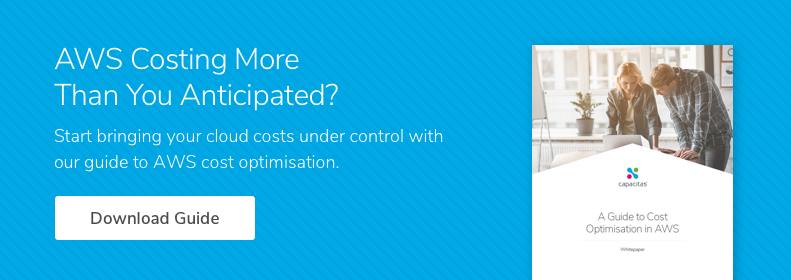The widespread embrace of cloud infrastructure has undoubtedly been a boon to businesses, bringing with it huge benefits in security, scalability and storage. However, there is a darker side to the clamour for cloud and many adopters have been left unprepared for the hidden fees that come with poor AWS cost management.
Without proper cost management, cloud offerings like AWS can quickly become expensive as businesses struggle to accurately track usage — running counter to the reason most switchover in the first place. However, it can be difficult to know how to begin with cost management. Where should you look first? And what are the first steps you should take towards cutting costs?
Identify that You Have a Problem
This may seem like an obvious place to start, but many businesses aren’t aware that they’re overspending on cloud infrastructure and continue to plough unnecessary costs into it. The proof’s in the proverbial pudding: in the last year alone, businesses are believed to have spent over $10bn on wasted cloud infrastructure.
But where should you be looking?
Well, there are five common challenges to controlling your costs in AWS:
- Oversizing
- Software inefficiency
- Sub-optimal architecture
- Application inelasticity
- Forecasting complexity
The simplest of these is oversizing, so that’s the obvious place to begin.
In the days before the cloud, it was commonplace for businesses to purchase additional infrastructure on top of their current business needs — effectively future-proofing hardware to prevent it getting in the way of growth.
Pre-cloud, this made complete sense: provisioning extra hardware was a lengthy process that involved large amounts of capital expenditure (CAPEX). What’s more, given the expense of buying the hardware outright, the investment usually needed the board buy-in — rarely a speedy process.
This isn’t the case with the cloud: additional capacity can be turned on and off as needed or triggered automatically, and the costs incorporated into monthly operating expenditure (OPEX). However, it seems many IT buyers didn’t get the memo and are still approaching capacity in the same, anachronistic fashion.
So, the first thing you should consider is whether you’re wasting capacity and if anything you’re using could be pared back.
In many cases, you’ll find overspend is linked to underlying performance issues and this is often where large savings can be achieved by making fixes and downsizing your cloud infrastructure accordingly. To achieve this, you’ll need to carry out performance testing to determine where the weak links in your system are.
Start with Low-hanging Fruit
Performance testing aside, there are a number of other ‘quick fixes’ that’ll help you immediately cut your wasteful cloud spend, including:
- Shutting down cloud capacity that isn’t being used
- Leveraging discount options with your provider
- Using more cost-effective regions for server storage
- Running dev instances only when needed
- Using reserved instances
- Implementing budget controls
There are tools on the market to help you automate these processes and track your cloud use — such as Amazon’s CloudWatch — however, it should be stressed that these tools are only as useful as users' understanding of their recommendations. We’ve often encountered businesses who are using these tools, but without a clear guide to implementing to the recommendations, have only ever managed to adopt a small fraction of them.
An alternative is to use a clear step-by-step process, such as our 6 step guide to guide to cost optimisation in AWS — proven to help businesses cut 70% of cloud overspend on average. Using a clear framework removes the ambiguity that can result from using a cloud capacity checker, instead, giving you an easy-to-follow route to tackling four out of five of the common challenges mentioned earlier.
Our guide outlines how to:
- Identify over-supply and software inefficiency
- Assess the risks and likely costs of optimising those inefficiencies
- Plan your optimisation and successfully test it
- Implement your optimisation in a live setting
- Validate the optimisation’s performance
- Remove technical constraints
Then Move onto Long-term Fixes
So, you’ve managed to cut the majority of your cloud overspend, but what are the next steps? How do you stop the same cycle repeating in 6 months’ time and how do you tackle the unnecessary costs not caught by quick fixes?
Forecasting. The long-term systemic fixes to cloud cost control are to be found in your business's ability to accurately predict your OPEX costs. If your cloud usage is to be cost-effective in the long-run, you need to probe a little deeper into what you're currently using and what you can expect to be using in the future.
Your analysis should look into whether your spending can be benchmarked against the market and similar workloads, the long-term scalability of your cloud architecture, how you'll prepare for peak trading times and how much the technology you choose is likely to cost as a result of these factors.
If that sounds a little daunting, it doesn't need to be. While complex, a thorough systemic analysis of your cloud infrastructure can help you tackle the deep-rooted drivers of cost inefficiencies long before they get out of control — so it's certainly worthwhile pursuing.
At
To get started on optimising your AWS cloud costs, download our 6-step guide.
